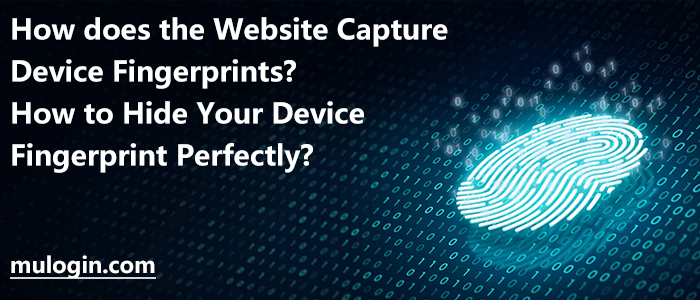Device fingerprinting is a technology used to identify and track devices. It generates a unique device identifier by collecting unique characteristics and attributes of the device, such as operating system version, browser type, screen resolution, language setting, hardware configuration, etc.
Device fingerprinting technology can be used for a variety of purposes, with one common application being in the areas of cyber security and anti-fraud. By analyzing and comparing device fingerprints, problems such as malicious behavior, fraudulent activities, and duplicate registrations can be identified and appropriate measures, such as blocking accounts and restricting access, can be taken.
Device fingerprints can be collected in a variety of ways, and the following are some common collection methods:
1. Browser fingerprint: Websites can obtain various attributes and configuration information of the browser through JavaScript code, such as User-Agent string, browser type, operating system, plug-in, font, time zone, etc.
2. IP address: Each device has a unique IP address on the Internet, and the IP address can be used to determine information such as the device’s geographic location and network provider.
3. Device attributes: By detecting the hardware attributes of the device, such as screen resolution, device model, operating system version, language setting, time zone, etc., a fingerprint of the device can be generated.
4. Cookies and local storage: Websites can use cookies and local storage to store some device identifiers for identification and matching in subsequent visits.
5. HTTP header information: By analyzing the HTTP request header information sent by the device, some device attributes and characteristics can be obtained, such as Referer, Accept-Language, Accept-Encoding, etc.
6. Accelerators and proxy servers: Some proxy servers and gas pedals add specific HTTP headers to the request, which can be used for device fingerprinting analysis and identification.
It should be noted that the collection of device fingerprints is usually non-sensitive, and users do not need to actively provide any information when visiting a website. At the same time, legitimate data collection should follow privacy protection principles, such as compliance with relevant privacy policies, anonymization processing, and data security.
If you want to mask device fingerprints, the following methods may be helpful to you:
1. Use an anonymous browser or privacy mode: Anonymous browsers or privacy modes can better protect your privacy because they usually restrict websites’ access to browser properties and configurations.
2. Disable or restrict browser plug-ins: Some browser plug-ins may provide additional information to websites. Disabling or restricting plug-ins can reduce the uniqueness of device fingerprints.
3. Use a proxy server or virtual fingerprint browser: A proxy server or fingerprint browser can hide your real IP address and network provider information, and change your virtual location, thus increasing the confusion of device fingerprints.
4. Clear cookies and local storage regularly: Clearing your browser’s cookies and local storage reduces the likelihood that websites will track and identify your device.
5. Change the User-Agent string (User-Agent) regularly: The User-Agent string is part of the information that the browser sends to the server, and changing the User-Agent string regularly can increase the diversity of device fingerprints.
6. Use privacy-enhancing browser extensions: Some browser extensions can help you reduce the uniqueness of device fingerprints, such as randomizing user-agents, disabling fingerprint collection scripts, etc.
MuLogin Antidetect Browser can create multiple unique fingerprint browsers, each browser’s fingerprint environment, cookies, local storage, and other cache files will be completely isolated, and browser profiles cannot leak information to each other for multi-account secure login without being associated.
Any work that is repetitive can be done in MuLogin through automation. And you can automate MuLogin through a range of Local APIs or tool libraries such as Selenium and Puppeteer.
In MuLogin Antidetect Browser, the master account can manage multiple sub-accounts, each of which operates independently. Users can easily control access to browser profiles for team members through the Share or Transfer Profiles feature. You can let the first administrator create accounts and then easily share these browser profiles with employees or transfer them to your customers for use. Data is synchronized with the cloud in real-time, and all operations can be done in the same environment, avoiding any risk and hassle and effectively boosting productivity!
